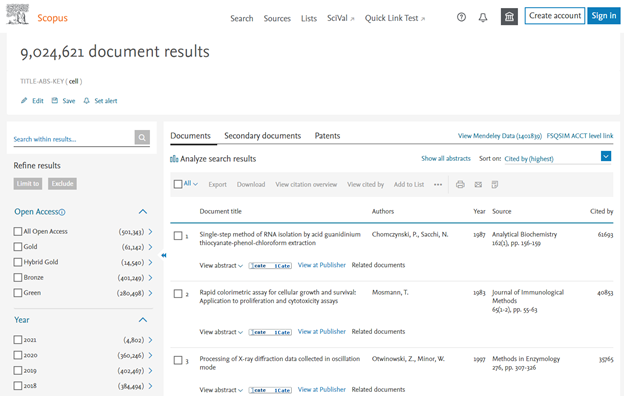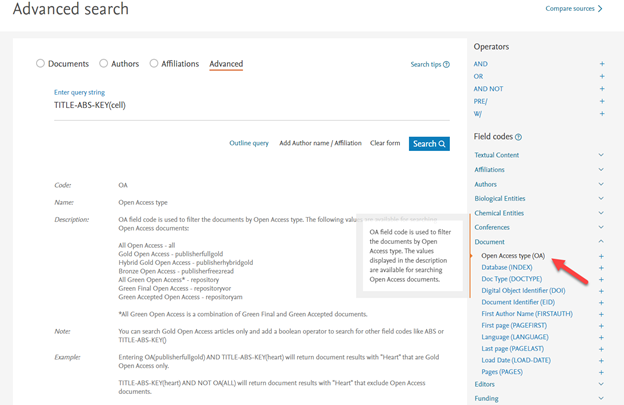Scopus filters for Open Access type and Green OA full-text access option
Scopus Open Access filters and new Green OA full-text access
In December 2020, Scopus introduced Open Access filters, providing greater clarity on the type of open access options for a given search. The new classification system released included an expanded definition of open access on Scopus, to include documents available in open repositories (typically referred as ‘Green OA'). As a result of these expansions, you can now filter your results on the Documents Results page on ‘all open access articles’ or use specific OA tags, i.e. gold, hybrid gold, green and bronze.
As part of the Scopus committment to providing access from discovery through to full-text, in January 2022, Scopus has expanded the Open Access offerings to include full-text access links to Green OA articles, where available. See more on this development in this full-text access blog post.
Learn more about the Scopus OA filters
Where are the Open Access definitions derived from?
The source of OA documents in Scopus is Unpaywall, a database run by Impactstory (a non-profit organization) which harvests Open Access content from over 50,000 publishers and repositories.
Which Open Access filters are supported in Scopus?
Scopus users can now see Open Access Gold, Hybrid-Gold, Green or Bronze status per document.
Furthermore, the Scopus advanced search page has been updated to allow users to build custom queries to include these new Open Access statuses. If users have a need to split out “Green Open Access” into “Green accepted” or “Green final” they will be able to do so on the Advanced search page and via the Scopus APIs.
The following open access filters are now available in Scopus:
| Facets | Information label | Definition | Examples |
|---|---|---|---|
| Gold | Gold (Open access-only journal) | Published version with Creative Commons license, available on publisher platform. Documents are in journals which only publish open access | Article from Heliyon Article from Global Health Action |
| Hybrid Gold | Gold (hybrid journal) | Published version with Creative Commons license, available on publisher platform. Documents are in journals which provide authors the choice of publishing open access | Article from Reliability Engineering & System Safety Article from Journal of Fluid Mechanics |
| Bronze | Other free-to-read at Publisher | Published version of record or manuscript accepted for publication, for which the publisher has chosen to provide temporary or permanent free access. Bronze status is assigned to a document if there is another (publisher-specific) license other than a Creative Commons license (e.g. Elsevier’s publisher license for Open Archive), or no license at all. | Open Archive |
| Green | Free-to-read at Repository | Published version or manuscript accepted for publication, available at repository. Documents may also be available gold or other free-to-read on the publisher platform | Any article with a version available in a repository identified by Unpaywall |
Where can I find the Open Access indicators and filters?
You can filter your results on the Documents Results page’s filter panel. You can filter on ‘all Open Access documents’ or specify each of the aforementioned OA tags, i.e. gold, hybrid gold, green and bronze.
For Scopus Advanced Search users, the OA filters can be found in the OA field code section. The below values in combination with the “OA” field code allow users to build queries using the OA filters.
The Advanced Search page also allows users to search for “Green Final” and “Green Accepted” OA documents if there is a need for a more granular view of Green OA documents. These two Green OA filters are not available on the Document Search results page filter panel.
| Open Access values | Description |
|---|---|
| all | All Open Access documents |
| publisherfullgold | Gold Open Access |
| publisherhybridgold | Hybrid Gold Open Access |
| publisherfree2read | Bronze Open Access |
| repository | All Green Open Access |
| repositoryvor | Green Final Open Access |
| repositoryam | Green Accepted Open Access |
*Note: All Green Open Access is a combination of Green Final and Green Accepted documents.
Examples of Advanced Search queries in combination with Open Access filters:
You can search Gold Open Access articles only and add a Boolean operator to search for other field codes like ABS or TITLE-ABS-KEY()
- Entering (OA(publisherfullgold) OR OA(publisherhybridgold)) AND TITLE-ABS-KEY(heart) will return document results with "Heart" that are Gold Open Access only.
- Entering TITLE-ABS-KEY(heart) AND NOT OA(ALL) will return document results with "Heart" that exclude Open Access documents.
Why am I seeing more documents per OA filter than the total document results count?
An Open Access document in Scopus can be tagged with more than one OA status as one article van be available in different OA version (e.g. “Gold and Green”). In the OA filter facet, you will see a count for Gold and Green for the same document.
Note: There is no duplicate counting for publisher-enabled OA documents (Gold, Hybrid-Gold and Bronze categories).
How often is the Open Access information updated in Scopus?
Scopus receives weekly updates from Unpaywall for the documents indexed in Scopus.
Are the Open Access filters available via the Scopus APIs?
Users can use the same search queries and OA values, as explained on the Advanced Search page, with the Scopus document search and retrieval APIs.
How can I identify which document is an Open Access document in Scopus?
On the Scopus document details page there is an “Open Access” label displayed to indicate that a document is Open Access.
On the Scopus document search results pages there is a “Open Access” label in each separate line item if a document is Open Access.
Can I search for the status of the Creative Commons license of a document in Scopus?
No, Creative Commons (CC) license information is not searchable via Scopus.
CiteScore and Open Access
With the new CiteScore methodology, publications in the four years up to and including the calculation year will now be included. This means that CiteScore can be calculated for journals with just a single year of publication, giving new journals – including many Open Access and China-focused journals – a first indication of their citation impact one year earlier than via the previous CiteScore methodology and earlier than they receive an impact factor.



